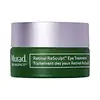What's inside
What's inside
 Key Ingredients
Key Ingredients

 Benefits
Benefits

 Concerns
Concerns

 Ingredients Side-by-side
Ingredients Side-by-side

Water
Skin ConditioningGlycerin
HumectantLactose
HumectantC12-15 Alkyl Benzoate
AntimicrobialCetearyl Ethylhexanoate
EmollientPEG-100 Stearate
Glyceryl Stearate
EmollientPEG-8
HumectantStearyl Alcohol
EmollientTromethamine
BufferingPanthenol
Skin ConditioningCarbomer
Emulsion StabilisingIsopropyl Myristate
EmollientMethylparaben
PreservativeDisodium EDTA
BHT
AntioxidantPropylparaben
PreservativeMagnesium Aspartate
Skin ConditioningZinc Gluconate
Skin ConditioningChlorhexidine Digluconate
AntimicrobialRetinol
Skin ConditioningPolysorbate 20
EmulsifyingCopper Gluconate
Skin ConditioningWater, Glycerin, Lactose, C12-15 Alkyl Benzoate, Cetearyl Ethylhexanoate, PEG-100 Stearate, Glyceryl Stearate, PEG-8, Stearyl Alcohol, Tromethamine, Panthenol, Carbomer, Isopropyl Myristate, Methylparaben, Disodium EDTA, BHT, Propylparaben, Magnesium Aspartate, Zinc Gluconate, Chlorhexidine Digluconate, Retinol, Polysorbate 20, Copper Gluconate
Water
Skin ConditioningCaprylic/Capric Triglyceride
MaskingC10-18 Triglycerides
EmollientGlycerin
HumectantButyrospermum Parkii Butter
Skin ConditioningHelianthus Annuus Seed Wax
Skin ConditioningPolyacrylate Crosspolymer-6
Emulsion StabilisingJojoba Esters
EmollientGlyceryl Stearates
EmollientCetearyl Alcohol
EmollientRetinal
Skin ConditioningAvena Sativa Kernel Extract
AbrasiveGentiana Lutea Root Extract
Skin ConditioningTetrapeptide-1
Skin ConditioningUrea
BufferingYeast Amino Acids
HumectantTrehalose
HumectantInositol
HumectantTaurine
BufferingBetaine
HumectantSimmondsia Chinensis Seed Oil
EmollientHydroxyacetophenone
AntioxidantTocopherol
AntioxidantAscorbyl Palmitate
AntioxidantPhosphatidylcholine
EmulsifyingMannitol
HumectantCetyl Alcohol
EmollientStearyl Alcohol
EmollientEthylhexylglycerin
Skin ConditioningPropanediol
SolventPolyglycerin-3
HumectantSodium Stearoyl Glutamate
CleansingXanthan Gum
EmulsifyingCaprylyl Glycol
EmollientSodium Chloride
MaskingLeuconostoc/Radish Root Ferment Filtrate
AntimicrobialTetrasodium Glutamate Diacetate
Citric Acid
BufferingChlorphenesin
AntimicrobialPotassium Sorbate
PreservativeSodium Benzoate
MaskingWater, Caprylic/Capric Triglyceride, C10-18 Triglycerides, Glycerin, Butyrospermum Parkii Butter, Helianthus Annuus Seed Wax, Polyacrylate Crosspolymer-6, Jojoba Esters, Glyceryl Stearates, Cetearyl Alcohol, Retinal, Avena Sativa Kernel Extract, Gentiana Lutea Root Extract, Tetrapeptide-1, Urea, Yeast Amino Acids, Trehalose, Inositol, Taurine, Betaine, Simmondsia Chinensis Seed Oil, Hydroxyacetophenone, Tocopherol, Ascorbyl Palmitate, Phosphatidylcholine, Mannitol, Cetyl Alcohol, Stearyl Alcohol, Ethylhexylglycerin, Propanediol, Polyglycerin-3, Sodium Stearoyl Glutamate, Xanthan Gum, Caprylyl Glycol, Sodium Chloride, Leuconostoc/Radish Root Ferment Filtrate, Tetrasodium Glutamate Diacetate, Citric Acid, Chlorphenesin, Potassium Sorbate, Sodium Benzoate
Ingredients Explained
These ingredients are found in both products.
Ingredients higher up in an ingredient list are typically present in a larger amount.
Glycerin is already naturally found in your skin. It helps moisturize and protect your skin.
A study from 2016 found glycerin to be more effective as a humectant than AHAs and hyaluronic acid.
As a humectant, it helps the skin stay hydrated by pulling moisture to your skin. The low molecular weight of glycerin allows it to pull moisture into the deeper layers of your skin.
Hydrated skin improves your skin barrier; Your skin barrier helps protect against irritants and bacteria.
Glycerin has also been found to have antimicrobial and antiviral properties. Due to these properties, glycerin is often used in wound and burn treatments.
In cosmetics, glycerin is usually derived from plants such as soybean or palm. However, it can also be sourced from animals, such as tallow or animal fat.
This ingredient is organic, colorless, odorless, and non-toxic.
Glycerin is the name for this ingredient in American English. British English uses Glycerol/Glycerine.
Learn more about GlycerinStearyl Alcohol is a type of fatty alcohol from stearic acid. It is a white, waxy compound used to emulsify ingredients.
Fatty Alcohols are most often used as an emollient or to thicken a product. Emollients help soothe and hydrate the skin by trapping moisture.
They are usually derived from natural fats and oils and therefore do not have the same drying or irritating effect as solvent alcohols. FDA allows products labeled "alcohol-free" to have fatty alcohols.
Learn more about Stearyl AlcoholWater. It's the most common cosmetic ingredient of all. You'll usually see it at the top of ingredient lists, meaning that it makes up the largest part of the product.
So why is it so popular? Water most often acts as a solvent - this means that it helps dissolve other ingredients into the formulation.
You'll also recognize water as that liquid we all need to stay alive. If you see this, drink a glass of water. Stay hydrated!
Learn more about Water